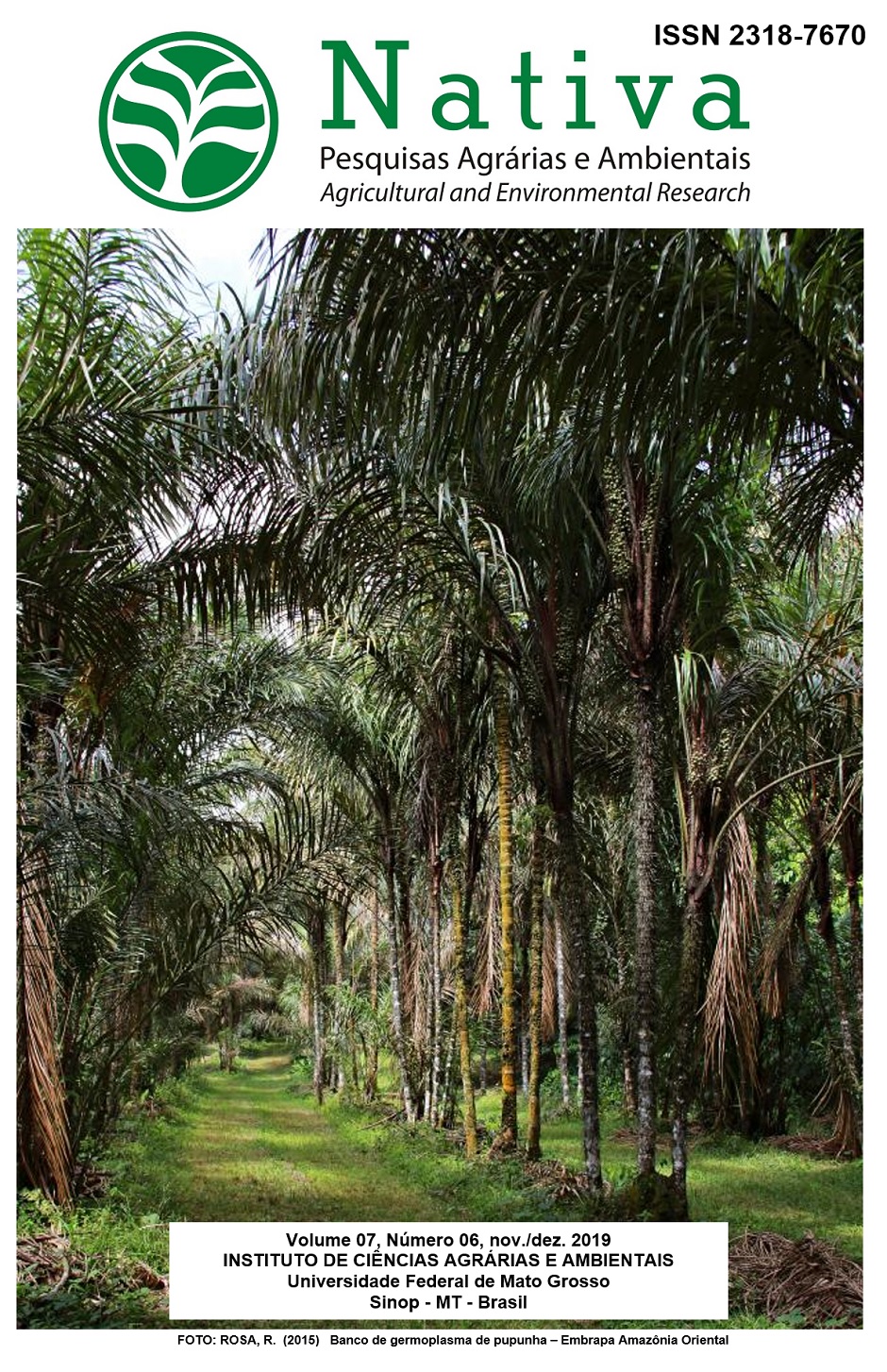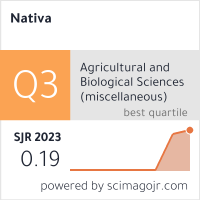ESTRUTURA E DIVERSIDADE DE UMA FLORESTA DE MIOMBO EM TARATIBU, NORTE DE MOÇAMBIQUE
DOI:
10.31413/nativa.v7i6.7198Resumo
O objetivo deste trabalho foi avaliar a estrutura e diversidade de uma floresta de Miombo localizada em Taratibu no Parque Nacional das Quirimbas região norte de Moçambique, a fim de subsidiar ações de manejo e conservação. Uma área de 3,1 ha foi dividida em 31 parcelas de 50 x 20 m, onde foi mensurado o DAP ≥ 10,0 cm das árvores observadas. A composição florística, parâmetros fitossociológicos e estrutura diamétrica foram usados para avaliar a estrutura horizontal. O índice de Shannon Wiener (H´) e Pielou (J´) para a diversidade. Foram registrados 1111 árvores, distribuídas em 38 espécies, 36 géneros e 12 famílias. A Fabaceae foi a família de maior importância ecológica com 39% das espécies. A floresta apresentou uma densidade de 358 arv.ha-1 e área basal de 16,57 m2.ha-1. A distribuição das árvores por classes diamétricas seguiu o padrão j-invertido, comum em florestas naturais, apesar disso, as classes 12,5; 17,5 e 42,5 cm apresentaram-se com deficit de 4, 10, e 3 arv.ha-1 respectivamente. O H´ e J´ foram de 2,19 e 0,60 respectivamente. Taratibu apresenta estrutura e diversidade florística estável, há no entanto necessidade de intervenção de manejo de modo a garantir a conservação deste ecossistema.
Palavras-chave: Taratibu; fitossociologia; conservação florestal; Parque Nacional das Quirimbas.
STRUCTURE AND FOREST DIVERSITY OF MIOMBO WOODLAND IN TARATIBU, NORTH OF MOZAMBIQUE
ABSTRACT:
The aim of this work was to evaluate the structure and forest diversity Miombo woodland located in Taratibu, in Quirimbas National park, northern of Mozambique, in order to subsidize actions of management and conservation. 3,1 ha, were divided into 31 plots of 50x20 m, where the DBH ≥ 10,0 cm of all observed trees were measured. Floristic composition, phytosociological parameters and diametric structure were used to evaluate the horizontal structure. Shannon Wiener and Pielou index were used to evaluate the forest diversity. There were 1111 trees, distributed in 38 species, 36 genera and 12 families. Fabaceae was the most ecologically important family with 39% of all species. The woodland had a density of 358 trees per hectare and a basal area of 16,57 m2.ha-1. The distribution of trees on diametric structure followed the j-inverted, typical of natural forests, however, the diametric classes of 12,5; 17,5 and 42,5 cm, showed, deficit of 4, 10, and 3 trees per hectare respectively. The Shannon and Pielou index were 2,19 and 0,6 respectively. Taratibu has stabilized structure and forest diversity, however management action is needed to maintain this ecosystem conserved.
Keywords: Taratibu; phytosociology; forest conservation; Quirimbas National Park.
Referências
AIMI, S. C.; ARAUJO, M. M.; RORATO, D. G.; DUTRA, A. F.; CALLEGARO, R. M. Estrutura horizontal e influência de características do solo em fragmento de Floresta Ombrófila Mista. Nativa, Sinop, v. 5, n. 2, p. 151–156, 2017. DOI: http://dx.doi.org/10.5935/2318-7670.v05n02a12
APG_THE ANGIOSPERM PHYLOGENY GROUP; CHASE, M. W.; CHRISTENHUSZ, M. J. M.; FAY, M. F.; BYNG, J. W.; JUDD, W. S.; MABBERLEY, D. J.; SENNIKOV, A. N.; SOLTIS, P. S; STEVES, P. F. The Angiosperm Phylogeny Group IV. An update of the Angiosperm Phylogeny Group Classification for the orders and families of higher plants: APG IV. Botanical Journal of the Linnean Society, v. 181, n. 1, p. 1-20, 2016. DOI: https://dx.doi.org/10.1111/boj.12385
CHIDUMAYO, E. N. Forest degradation and recovery in a Miombo woodland landscape in Zambia: 22 years of observations on permanent sample plots. Forest Ecology and Management, Amsterdam, v. 291, p. 154-161, 2013. DOI: http://dx.doi.org/10.1016/j.foreco.2012.11.031
CIENTEC_CONSULTORIA E DESENVOLVIMENTO DE SISTEMAS. Software Mata Nativa 2: Sistema para Análise Fitossociológica, Elaboração de Inventários e Planos de Manejo de Florestas Nativas. Viçosa: Cientec, 2006. 295 p.
CORAIOLA, M.; NETTO, S. P. Análise da estrutura horizontal de uma floresta estacional semidecidual localizada no Município de Cássia-MG. Revista Acadêmica: ciências agrárias e ambientais, Curitiba, v. 1, n. 4, p. 11-19. 2003. DOI: http://dx.doi.org/10.7213/cienciaanimal.v1i4.14961
DEWEES, P. A.; CAMPBELL, B. M.; KATERERE, Y.; SITOE, A.; CUNNINGHAM, A. B.; ANGELSEN, A.; WUNDER, S. Managing the Miombo woodlands of southern Africa: Policies, incentives and options for the rural poor. Natural Resources Policy Research, v. 2, n. 1, p. 57-73, 2010. http://dx.doi.org/10.1080/19390450903350846
EIA_ENVIRONMENTAL INVESTIGATION AGENCY. Conexões de primeira classe: Contrabando, corte ilegal de madeira e corrupção em Moçambique.. Washington: Environmental Investigation Agency, 2014. 16 p.
EKMAN, S-M. S.; WENBIN, H.; LANGA, E. Comércio e investimento chinês na indústria madeireira de Moçambique: Um estudo de caso da província de Cabo Delgado. Bogor: CIFOR. 2014. 44 p. (Documento de trabalho, 132).
GILIBA, R. A., BOON, E. K., KAYOMBO, C. J., MUSAMBA, E. B., KASHINDYE, A. M., & SHAYO, P. F. Species composition, richness and diversity in Miombo woodland of Bereku Forest Reserve, Tanzania. Journal of Biodiversity, v. 2, n. 1, p. 1-7, 2011.
GELDENHUYS, C. J. Basic guidelines for silvicultural and management practices in Mozambique. Report FW-04/05, Forestwood, Pretoria, 2005. 78 p.
GONÇALVES, F. M. P.; REVERMANN, A. G.; AIDAR, M. P. M.; FINCKH, M.; JUERGENS, N. Tree species diversity and composition of Miombo woodlands in South-Central Angola: A chronosequence of forest recovery after shifting cultivation. International Journal of Forestry Research, v. 2017, p. 1–13, 2017. http://dx.doi.org/10.1155/2017/6202093
HOFIÇO, N. S. A.; FLEIG, F, D. Diversity and structure of Miombo woodlands in Mozambique using a range of sampling sizes. Journal of Agricultural Science and Technology, v. 5, n. 10, p. 679-690, 2015. https://doi.org/10.17265/2161-6264/2015.10.005.
HOFIÇO, N. S. A.; COSTA, E. A.; FLEIG, F, D.; NANVONAMUQUITXO, S. J. A. Regulation of the diametric structure of the Miombo Woodland using the De Liocourt method in Mozambique. Nativa Snop, v. 4, n. 6, p. 407-414, 2018. http://dx.doi.org/10.31413/nativa.v6i4.5396
ISANGO, J. Stand structure and tree species composition of Tanzania Miombo woodlands: A case study from Miombo woodlands of community based forest management in Iringa District. Working Papers of the Finnish Forest Research Institute, n. 50, p. 43–56, 2007.
KALABA, F. K.; QUINNA, C. H.; DOUGILL, A. J.; VINYA, R. Floristic composition, species diversity and carbon storage in charcoal and agriculture fallows and management implications in Miombo woodlands of Zambia. Forest Ecology and Management, Amsterdam, v. 304, p. 99–109, 2013. DOI: http://dx.doi.org/10.1016/j.foreco.2013.04.024
KENT, M.; COKER, P. Vegetation description and analysis, a pratical approach. Oxford: Wiley- Blackweel, 2011. 414 p.
KERSHAW JR, J. A.; DUCEY, M. J.; BEERS, T. W.; HUSCH, B. Forest Mensuration. 5. ed. Oxford: Wiley-Blackwell, 2016. 630 p.
MACKENZIE, C. Forest governance in Zambezia, Mozambique: Chinese takeaway! Final report for FONGZA. Maputo: Fórum das organizações não governamentais da Zambézia, 2006. 96 p.
MACKENZIE, C.; RIBEIRO, D. Tristezas tropicais: More sad stories from the forests of Zambézia. Amigos da Floresta e Justiça Ambiental, Maputo, Moçambique. 2009. 63 p.
MALMER, A. General ecological features of Miombo woodlands and considerations for utilization and management. Working Papers of the Finnish Forest Research Institute, v. 50, p. 34–42. 2007.
MATE, R.; JOHANSSON, T.; SITOE, A. Biomass equations for tropical forest tree species in Mozambique. Forests, v. 5, n. 3, p. 535-556, 2014. https://dx.doi.org/10.3390/f5030535
MILES, L.; NEWTON, A. C.; DEFRIES, R. S.; RAVILIOUS, C.; MAY, I.; BLYTH, S.; GORDON, J. E. A global overview of the conservation status of tropical dry forests. Journal of Biogeography, Oxford, v. 33, n. 3, p. 491–505, 2006. DOI: https://doi.org/10.1111/j.1365-2699.2005.01424.x
MAE_MINISTÉRIO D ADMINISTRAÇÃO ESTATAL. Perfil do distrito de Ancuabe, província de Cabo Delgado. 2005. Disponível em: http://www.ine.gov.mz/documentos/outros-documentos/perfil-do-distrito-de-ancuabe-cabo-delgado.pdf/vie. Acesso em: 23/06/2018
MITADER. Defeso na exploração de pau-ferro, Swartzia madagascariensis espécie produtora de madeira de primeira classe, por período de cinco anos. Decreto Ministerial n˚ 10/2016. Ministério da Terra Ambiente e Desenvolvimento Rural de Moçambique (MITADER). Maputo, 2016.
PEREIRA, C. R. Estimating and mapping forest inventory variables using the K-NN method: Mocuba district case study, Mozambique. 2006. 86f. Doctoral thesis (Department of Environmental Science and Technology) – Tuscia University, Viterbo, Italy, 2006.
RIBEIRO, N. S.; JETIMANE, J. L.; MILITÃO, E.; MAQUIA, I.; CHIRIZANE, C.; DE SOUSA, C.; ALVES, T.; VELOSO, M. M.; GOULAO, L. F.; RIBEIRO-BARROS, A. I. Ecological characterization of an ex situ conservation plantation in South-Eastern Mozambique. African Journal of Ecology, Oxford, v. 55, n. 1, p. 70–79, 2017. https://dx.doi.org/10.1111/aje.12320
RIBEIRO, N. S.; SHUGART, H. H.; WASHINGTONALLEN, R. The effects of fire and elephants on species composition and structure of the Niassa Reserve, Northern Mozambique. Forest Ecology and Management, Amsterdam, v. 255, n. 5, p. 1626–1636, 2008. DOI: http://dx.doi.org/10.1016/j.foreco.2007.11.033
RYAN, C. M.; WILLIAMS, M. How does fire intensity and frequency affect Miombo woodland tree populations and biomass? Ecological applications, Washington, v. 21, n. 1, p. 48–60, 2011. DOI: https://dx.doi.org/10.1890/09-1489.1
RYAN, C. M.; WILLIAMS, M.; GRACE, J. Above and below ground carbon stocks in a Miombo woodland landscape of Mozambique. Biotropica, Hoboken, v. 43, n. 4, p. 423-43. 2011. DOI: https://doi.org/10.1111/j.1744-7429.2010.00713.x
SANTOS, R. O. dos; SOARES, R. N.; DANTAS, B. DE S.; ABREU, J. C. de; LIMA, R. B. de. Processos amostrais para estimativa de parâmetros estruturais de uma floresta estuáriana no estado do Amapá. Nativa, Sinop, v. 4, n. 5, p. 308–316. 2016. DOI: https://doi.org/10.14583/2318-7670.v04n05a07
SAS INSTITUTE INC. SAS Institute Inc., Cary, NC, USA. 2011.
SHIRIMA, D. D.; MUNISHI, P. K. T.; LEWIS, S. L.; BURGESS, N. D.; MARSHALL, A. R.; BALMFORD, A.; SWETNAM, R. D.; ZAHABU, E. M. Carbon storage, structure and composition of Miombo woodlands in Tanzania’s eastern arc mountains. African Journal of Ecology, Oxford, v. 49, n. 3, p. 332-342. 2011. DOI: https://doi.org/10.1111/j.1365-2028.2011.01269.x
SITOE, A.; MACANDZA, V.; JORGE, P.; GABRIEL, A.; CARVALHO, M.; AMADE, F. Biodiversity baseline of the Quirimbas National Park – Mozambique. Final Report. Universidade Eduardo Mondlane. C. P. 275, Maputo, Mozambique. 2010.
VAN WYK, B.; VAN WYK, P. Field guide to trees of Southern Africa. Cape Town: Struik publishers, 2011. 536 p.
WILLIAMS, M.; RYAN, C. M.; REES, R. M.; SAMBANE, E.; FERNANDO, J.; GRACE, J. Carbon sequestration and biodiversity of re-growing Miombo woodlands in Mozambique. Forest Ecology and Management, Amsterdam, v. 254, n. 2, p. 145–155. 2008. DOI: https://doi.org/10.1016/j.foreco.2007.07.033.
WWF_WORLD WILDLIFE FUND. Só no distrito de Ancuabe: Pelo menos 89 elefantes foram mortos por furtivos nos últimos 18 meses. Mozambique: WWF, 2013. Obtido 11 de Junho de 2017, de http://www.wwf.org.mz/?1340/S-no-distrito-de-Ancuabe-Pelo-menos-89-elefantes-foram-mortos-por-furtivos-nos-ltimos-18-meses.
ZOLHO, R. Effect of fire frequency on the regeneration of Miombo woodland in Nhambita, Mozambique. 2005. 71f. Master dissertation (Institute of Ecology and Resource Management) – University of Edinburgh, Edinburgh Scotland, 2005.
Downloads
Publicado
Como Citar
Edição
Seção
Licença
Direitos Autorais para artigos publicados nesta revista são do autor, com direitos de primeira publicação para a revista. Em virtude de a aparecerem nesta revista de acesso público, os artigos são de uso gratuito, com atribuições próprias, em aplicações educacionais e não-comerciais.
A artigos publicados nessa revista, podem ser reproduzidos parcialmente ou utilizados como referência por outros autores, desde que seja cita a fonte, ou seja, a Revista Nativa.
Copyright for articles published in this journal are the authors, with first publication rights granted to the journal. The journal shows open access, and articles are free to use, with proper attribution, in educational and non-commercial.
The articles published in this journal may be reproduced in part or used as a reference by other authors, provided that the source is quoted.






